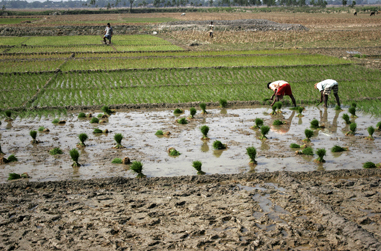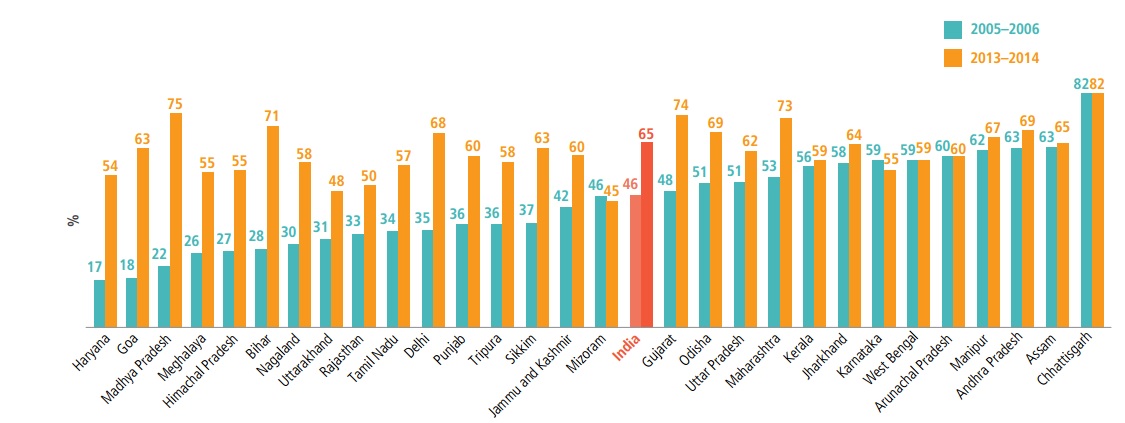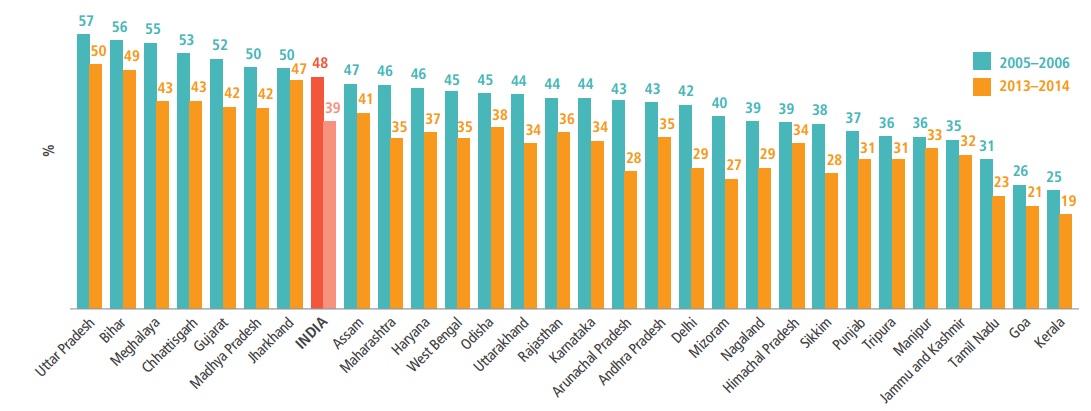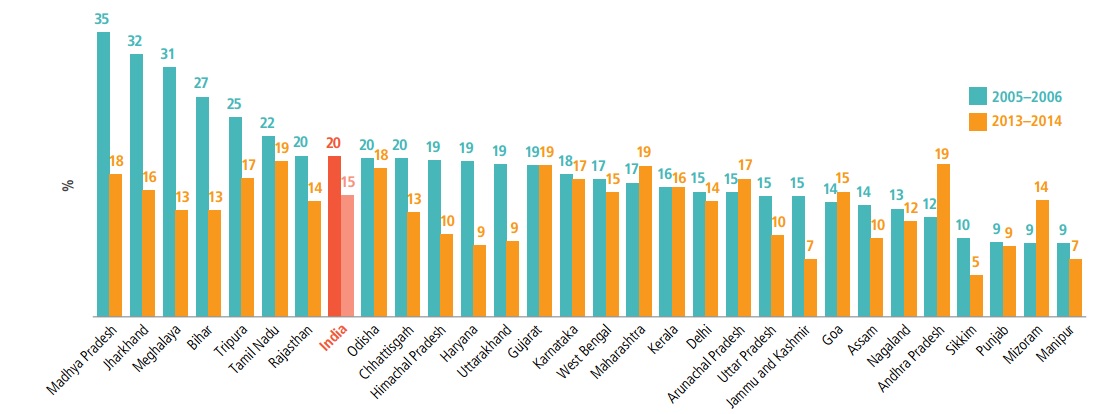
IFPRI report shows under-nutrition has fallen
 Published on Sep 21, 2015
Published on Sep 21, 2015
 Modified on Jan 13, 2016
Modified on Jan 13, 2016
|
The country has made significant gains in raising the rate of exclusive breastfeeding among infants from 46 to 65 percent between 2005-06 and 2013-14. This has been revealed by the 2015 Global Nutrition Report, which was released by the International Food Policy Research Institute (IFPRI) in September. The report has quoted preliminary data on nutrition, which was collected via the Rapid Survey on Children (RSOC) in 29 states by the Ministry of Women and Child Development in partnership with UNICEF India during 2013-14. Back in 2005–06, only 5 out of 29 states had exclusive breastfeeding rates of 60 percent or higher. Presently 17 states have breastfeeding rates of 60 percent or above. Even the erstwhile poor performing states such as Haryana, Goa, Madhya Pradesh and Meghalaya, among others, have exhibited significant progress in improving exclusive breastfeeding rates, finds the 2015 Global Nutrition Report (see chart 1). Chart 1: Exclusive breastfeeding rates in 2005–2006 and 2013–2014 in 29 Indian states  Source: 2015 Global Nutrition Report, based on data from India, Ministry of Women and Child Development (2015) Apart from the nation as a whole, nearly all states have exhibited significant declines in stunting rates among children below 5 years age between 2005-06 and 2013-14, says the report. The rate of stunting, i.e. proportion of stunted Indian children below age 5 years, has fallen from 48 percent in 2005–2006 to 39 percent in 2013-14, says the 2015 Global Nutrition Report. Three states i.e. Bihar, Jharkhand, and Uttar Pradesh, which had very high rates of child stunting during the NFHS-3 (i.e. 3rd round of National Family Health Survey, which was conducted in 2005-06), have demonstrated the slowest declines in stunting between 2005-06 and 2013-14. In contrast, states like Arunachal Pradesh, Mizoram and Delhi, with low stunting rates during NFHS-3, have witnessed the fastest average annual rates of decline in stunting between the two survey years. Chart 2: Stunting rates in 2005–2006 and 2013–2014 in 29 Indian states  Source: 2015 Global Nutrition Report, based on data from India, Ministry of Women and Child Development (2015) It can be seen from the chart above that in 21 out of 29 states during 2013-14, stunting rates are still higher than 30 percent, which means that in these states more than 30 percent of children below five years age are stunted. According to the UNICEF (please click here to access), stunting, or low height for age, is caused by long-term insufficient nutrient intake and frequent infections. Stunting generally happens before two years of age, and the effects are largely irreversible. These include delayed motor development, impaired cognitive function and poor school performance. Chart 3: Wasting rates in 2005–2006 and 2013–2014 in 29 Indian states  Source: 2015 Global Nutrition Report, based on data from India, Ministry of Women and Child Development (2015) IFPRI's 2015 Global Nutrition Report says that the rate of wasting, i.e. proportion of Indian children below age 5 years affected by wasting, has fallen from 20 percent in 2005–2006 to 15 percent in 2013-14. Except Maharashtra, Arunachal Pradesh, Goa, Andhra Pradesh and Mizoram, most of the states have witnessed declines in wasting (see chart 3). However, the IFPRI report recommends that the figures on wasting should be viewed with caution because they vary by season even more than stunting rates do. The report has, therefore, asked for more research so as to understand why progress in reducing wasting in India appears to be so uneven. According to the UNICEF (please click here to access), wasting, or low weight for height, is a strong predictor of mortality among children under five years of age. Wasting occurs due to recent food deprivation or serious illness. The prevalence of obesity among both sexes has increased from 4.0 percent in 2010 to 4.9 percent in 2014, finds the report. Among Indian males, the prevalence of obesity has increased from 2.5 percent to 3.2 percent between 2010 and 2014. Among Indian females, the prevalence of obesity has increased from 5.6 percent to 6.7 percent between 2010 and 2014. The Global Nutrition Report 2014 had noted that RSOC's data and methodologies have not yet been reviewed by international agencies like WHO and UNICEF, and the survey results have not yet appeared in the WHO’s Global Database on Child Growth and Malnutrition. References: 2015 Global Nutrition Report: Actions and Accountability to Advance Nutrition & Sustainable Development, IFPRI (released in September 2015), please click here to access Global Nutrition Report 2014: Actions and Accountability to Accelerate the World's Progress on Nutrition, IFPRI, please click here to access Child Malnutrition declining, though not fast enough, please click here to access Doubts over Maharashtra's Nutritional Progress?, please click here to access India’s Malnutrition Shame -Rajib Dasgupta, The Indian Express, 17 September, 2015, please click here to access Small leap forward in child health -Jean Drèze, The Hindu, 16 September, 2015, please click here to access Politics of Food -Gayatri Jayaraman, India Today, 9 September, 2015, please click here to access Some improvements in child malnutrition: data -Rukmini S, The Hindu, 22 August, 2015, please click here to access Grim picture -TK Rajalakshmi, Frontline, 7 August, 2015, please click here to access Suppression of Child Malnutrition Survey Data to Shield Gujarat -Amit Sengupta, Newsclick.in, 9 July, 2015, please click here to access Dramatic drop in number of underfed children: UNICEF -Rukmini S, The Hindu, 6 July, 2015, please click here to access Of secrecy and stunting, The Economist, 4 July, 2015, please click here to access India's malnourished infants, The Economist, 2 July, 2015, please click here to access How hungry is India? -Archana Mishra, Tehelka, 20 June, 2015, Issue 25, Volume 12, please click here to access No national nutrition survey in last 10 years -Rema Nagarajan, The Times of India, 5 April, 2015, please click here to access Policy on child malnutrition uses old data -Rema Nagarajan, The Times of India, 11 March, 2015, please click here to access 'Child stunting drops sharply in India', The Hindu, 13 November, 2014, please click here to access Image Courtesy: UNDP India
|
Tagged with: Wasting Stunting Child Health Right to Food child malnutrition nutrition Malnutrition Undernutrition Breastfeeding Exclusive Breastfeeding










Write Comments